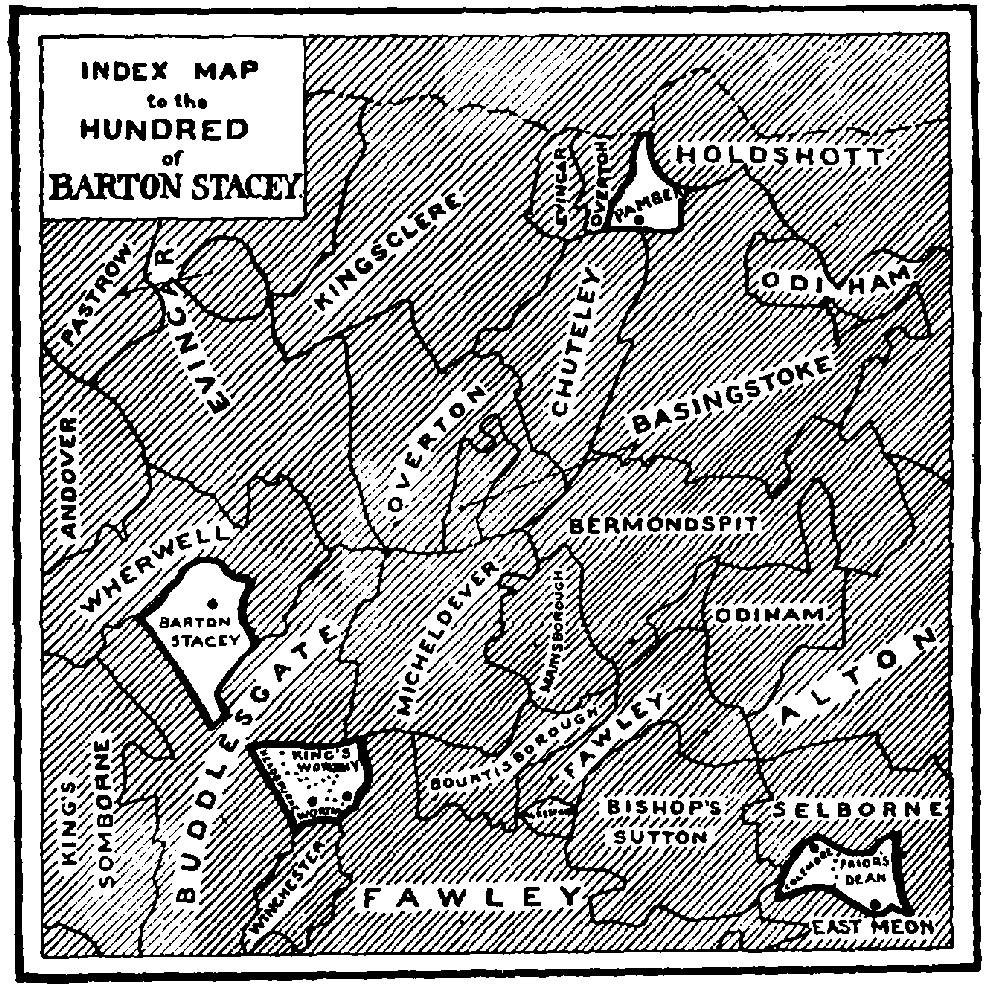A History of the County of Hampshire: Volume 4. Originally published by Victoria County History, London, 1911.
This free content was digitised by double rekeying. All rights reserved.
'The hundred of Barton Stacey', in A History of the County of Hampshire: Volume 4, (London, 1911) pp. 415-416. British History Online https://www.british-history.ac.uk/vch/hants/vol4/pp415-416 [accessed 10 May 2024]
THE HUNDRED OF BARTON STACEY
containing the parishes of Barton Stacey; Colemore; Headbourne Worthy; Kings Worthy; Pamber; Priors Dean (fn. 1)
At the time of the Domesday Survey the hundred of Barton Stacey included Barton Stacey, Bransbury, Colemore, Headbourne Worthy, Kings Worthy, Newton Stacey, Norton Valery, Sutton Scotney and Wonston. (fn. 2) The land assessed amounted to 17½ hides and 1 virgate, but Barton Stacey, of which Kings Worthy was then an appurtenance, had not, with the exception of half a hide, been assessed. (fn. 3) Drayton and Abbots Worthy, which are now tithings of Barton Stacey and Kings Worthy respectively, were then in the hundred of Micheldever, (fn. 4) and Pamber was perhaps in Basingstoke Hundred, of which it was a member in 1260. (fn. 5)

Index Map to the Hundred of Barton Stacey.
By 1316 the hundred was considerably changed; Pamber and Inhurst had been added, (fn. 6) while Bransbury, Norton Valery and Wonston were included in Buddlesgate Hundred. (fn. 7)
In the 16th century the hundred of Barton Stacey remained unaltered, (fn. 8) but Inhurst does not seem to have been included in 1652, (fn. 9) and it is given in the return of Baughurst in 1831, (fn. 10) in which year Bransbury, Drayton and Newton Stacey were returned as tithings of Barton Stacey parish, while Sutton Scotney was added to the parish of Wonston. (fn. 11)
Colemore and Priors Dean, though the latter is not mentioned in the Domesday Survey, belonged to the hundred of Barton Stacey till they were included in the upper half-hundred of East Meon in 1834, (fn. 12) in which year the Worthies were transferred to Fawley and Pamber to Basingstoke Hundred, (fn. 13) so that the hundred of Barton Stacey was reduced to the parish of that name, with its tithings of Bransbury, Drayton and Newton Stacey.
The hundred of Barton Stacey was granted by King John to Rogo de Sacy or Stacey in 1206, (fn. 14) and afterwards remained in the possession of the lords of the manor of Barton Stacey. When the estate was divided between the daughters and co-heiresses of Aimery de Sacy, the profits of the court which was held at Barton Stacey were also divided, (fn. 15) and they were shared by the lords of the moieties till the whole manor came into the hands of Thomas Salmon in 1577. (fn. 16)
A survey of the hundred was taken by the Parliamentary Commissioners in 1652, (fn. 17) but this seems to have been owing to a mistake, for it was never in the possession of Charles I.
